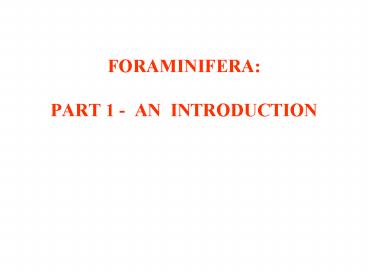FORAMINIFERA: PART 1 AN INTRODUCTION - PowerPoint PPT Presentation
1 / 17
Title:
FORAMINIFERA: PART 1 AN INTRODUCTION
Description:
50 to 60 species of living planktic forams. Many thousands of living benthic species ... Early organic walled & arenaceous forams in Cambrian ... – PowerPoint PPT presentation
Number of Views:320
Avg rating:3.0/5.0
Title: FORAMINIFERA: PART 1 AN INTRODUCTION
1
FORAMINIFERAPART 1 - AN INTRODUCTION
2
FORAMINIFERA
- Single-celled
- Amoeba- like
- Testate usually
- multichambered
- Net-like pseudopods
- Anastomosing
- Reticulating
- Dimorphic life cycles are complex
- Nearly 4 000 genera known
- 60 000 species known!
3
LIVE FORAM
- Note pseudopodia capturing food particles
- Note multichambered calcareous skeleton
4
MULTICHAMBERED FORAM SKELETON
5
DIFFERENT SPECIES OF FORAMS
6
FORAMINIFERA
- 50 to 60 species of living planktic forams
- Many thousands of living benthic species
- 1 000 genera living
- Up to 1 million individuals per square metre
benthos - Movement-feeding categories
- Crawling
- Mudeaters (detritus feeders)
- Micropredators
- Herbivores
- Burrowing mudeaters
- Reclining suspension feeders
- Encrusting suspension feeders
7
Microscopes used in Studies
- Transmitted light whole mounts
- Transmitted light thin sections
- Reflected light
- SEM
8
Sample Preparation
- Study unconsolidated sediments as the 1st choice
- Wash (heat baking soda) any fines from
sediments - Sieve coarse and separate sand fractions
- Juveniles tend to look alike even among
different genera, so pick 0.125 mm fraction
above - Some shale can be broken down by heating in water
soaking in organic solvents. Then, treated as
above. - Other rocks Simply boiling crushed samples with
baking soda helps to release some sediment - Thin sections may be resorted to, but usually
thin section studies not very effective, except
for fusulinids a few other kinds of forams.
9
Generalized History Based on Wall Composition
Structure
- Note
- Early organic walled arenaceous forams in
Cambrian - Calcareous microgranular forams in Ordovician
- Porcelaneous in Carboniferous
- Hyaline in Permian
- Planktic in Late Jurassic
- Nummulitids Late K to Early Cenozoic
10
Review Early History of Forams
11
Review Later History of Forams
12
CHALK FORAMS IN A "FINE-GRAINED MATRIX"
13
Application of Foram Studies
- Very useful indicators for
- Biostratigraphy
- Dating
- Correlation
- Paleoenvironments
- Depths
- Climates
- Habitats
- Paloeautecology (species) paleosynecology
(community) - Evolution
- Gradualistic phenomena
- Punctuated equilibrium examples
14
CLIMATE CHANGES INTERPRETEDFROM DEEP-SEA CORES
- Identification of planktic foraminiferal species
- Date layers in deep-sea cores.
- Plotting the abundance of cold and warm climate
species from core samples indicates climatic
changes through time.
15
CLIMATE CHANGES INTERPRETEDFROM DEEP-SEA CORES
- O18/O16 ratios from used to determine
- Paleotemperature changes with planktic species
- Ice-volume changes with benthic species
Triserial, planktic
16
END OF FILE
17
(No Transcript)































